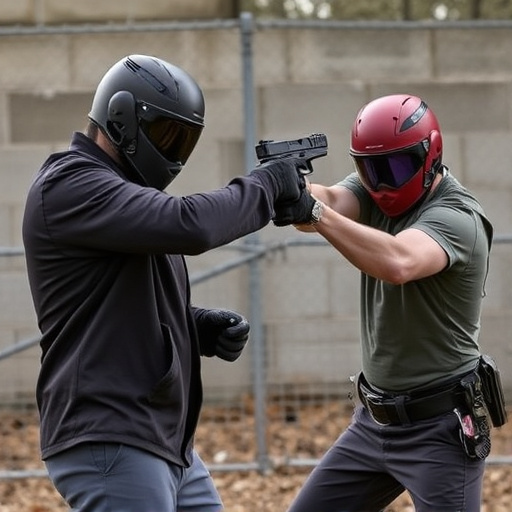Immediate and correct pepper spray eye washing is critical to mitigating discomfort and preventing long-term eye damage. This involves safely removing eyewear, rinsing with clean water for at least 15 minutes while blinking frequently, and seeking medical attention for persistent irritation or severe symptoms. Proper procedures ensure thorough flushing of capsaicin, the active ingredient in pepper spray, promoting eye health and reducing risks associated with riot control agents.
“Uncover the power of inflammatory riot control spray dispensers—a game-changer in crowd control. This comprehensive guide delves into the intricacies of pepper spray, its active ingredients, and immediate effects. Learn the critical eye washing procedure, ensuring best practices for safety and efficacy.
Explore riot control sprays’ legal and training considerations, as understanding these is essential for responsible deployment. From de-escalation techniques to post-exposure care, this article equips you with vital knowledge, especially in today’s dynamic social landscape.”
- Understanding Pepper Spray: Active Ingredients & Effects
- Eye Washing Procedure: Steps & Best Practices
- Riot Control Sprays: Safety, Training, and Legal Considerations
Understanding Pepper Spray: Active Ingredients & Effects
Pepper spray, a common riot control agent, is designed to disrupt normal bodily functions and create a temporary incapacitation. Its primary active ingredient is capsaicin, derived from chili peppers. When deployed, pepper spray causes irritations in the eyes, nose, throat, and skin, leading to tears, coughing, difficulty breathing, and pain.
The Pepper Spray Eye Washing Procedure is a critical step in mitigating the effects of exposure. It involves immediate eye closure, frequent blinking, and thorough washing with clean water for at least 15 minutes. This process helps flush out the irritant, alleviating discomfort and preventing potential long-term damage. Understanding these active ingredients and their effects empowers individuals to respond appropriately during encounters involving riot control spray.
Eye Washing Procedure: Steps & Best Practices
In the event of exposure to pepper spray, immediate and proper eye washing procedure is crucial to minimise discomfort and potential damage. Here’s a step-by-step guide for effective eye washing after coming into contact with pepper spray:
1. Remove Eyewear Safely: If you’re wearing glasses or protective eyewear, carefully remove them to prevent any obstructions during the washing process. Ensure that you don’t touch the inside of your eyes or the affected area with your hands to avoid further irritation.
2. Rinse with Clean Water: Hold your head under a gentle, running tap and completely submerge your face for at least 15 minutes. Make sure clean, unchlorinated water is used if possible. The flow should be directed from the nose towards the affected eyes to flush out the irritants.
3. Blink Frequently: While rinsing, blink your eyes slowly and frequently. This helps in spreading natural tears across the eye surface, lubricating and soothing them.
4. Seek Medical Attention if Necessary: Even after thorough rinsing, if irritation persists or you experience severe pain, vision changes, or any unusual symptoms, immediate medical attention is advised. Consult a healthcare professional for further guidance and treatment options.
Riot Control Sprays: Safety, Training, and Legal Considerations
Riot control sprays, a common tool in law enforcement and security operations, necessitate careful consideration regarding safety, training, and legal aspects. These powerful agents can quickly de-escalate volatile situations but must be used responsibly to avoid harm. One crucial aspect is proper eye washing procedure after exposure to pepper spray. In the heat of a riot or security operation, officers and bystanders may inadvertently come into contact with these irritants, leading to temporary blindness and severe discomfort.
Comprehensive training programs are essential to educate personnel on the safe handling and deployment of riot control sprays. This includes demonstrating effective eye washing techniques, especially in scenarios where personal protective equipment (PPE) might limit visibility. Additionally, legal considerations play a significant role; understanding local laws and regulations regarding the use of such agents ensures compliance and helps protect both the public and law enforcement officers from potential misuse or excessive force claims.
The proper use of pepper spray and understanding its effects, along with effective eye washing procedures, are essential tools for navigating volatile situations. Always prioritize safety, ensure comprehensive training, and stay informed about legal considerations surrounding riot control sprays. By adhering to these practices, individuals can effectively manage high-pressure scenarios while minimizing risks and ensuring the well-being of all involved.
